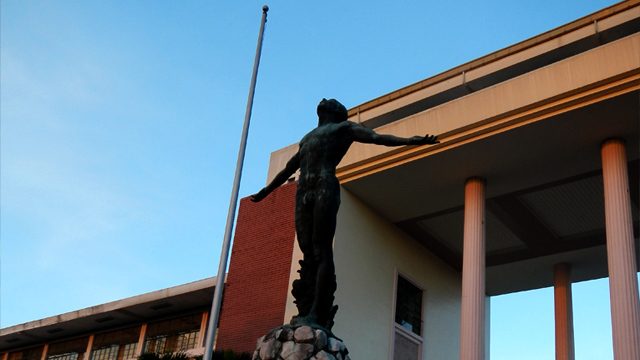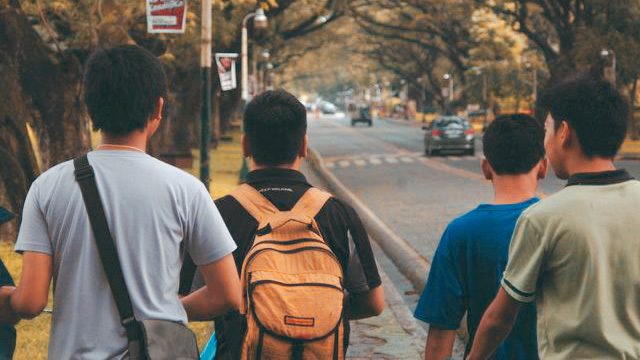SUMMARY
This is AI generated summarization, which may have errors. For context, always refer to the full article.

MANILA, Philippines – The new law that assures top graduates from public high schools with a one-year scholarship in state universities and colleges (SUCs) allows automatic admission for the next 6 years starting school year 2015-2016.
But the University of the Philippines (UP) still urged students in the running for top 10 to take the UP College Admission Test (UPCAT) before they graduate from high school.
“By default, [UPCAT passers] will be the first ones because they are already admitted, then they can easily claim their scholarship because they already have the admittance letter. So in the counting, they will be prioritized,” UP vice president for public affairs Prospero de Vera said in an interview on Wednesday, June 17.
After all, he added, if the students are really in the top 10, the probability of making it to UP is higher. Taking the entrance exam will save them from any admission issue.
During Congress deliberations on Republic Act 10648 or the Iskolar ng Bayan Act of 2014, UP was initially excluded from SUCs that will sponsor the top graduates from public high schools. Because of this, they were not included in public hearings.
This poses a problem when it comes to the language of the law, De Vera said. (READ: UP education: Burden of students or the state?)
“We support Iskolar ng Bayan, We support affirmative action, but we’re having a problem how to do it,” he said.
De Vera cited 3 issues:
- The concept of regional university. According to the implementing rules and regulations (IRR) of RA 10648, the top 10 from every 500 graduates can automatically be admitted to their SUCs of choice within the region during the transition period of 6 years beginning school year 2015-2016.
“UP does not have regional universities. Many regions do not have a UP campus. That provision is very difficult to apply as far as UP is concerned,” De Vera said. - Socialized tuition. Months before the IRR was signed on April 13, UP didn’t know how it would go about the scholarship since its tuition system is socialized, unlike other SUCs.
In the IRR, the scholarship is equivalent to the full amount of the school’s tuition and other school fees in the freshman year.
For schools with a socialized tuition system, Iskolar ng Bayan recipients will be assessed using the lowest rates. For UP, the student will be assigned to Bracket E, which means free tuition.
But De Vera is worried about the scholars’ next years in UP, because they may be assigned to a higher bracket with a higher tuition rate after their Socialized Tuition System assessment, unless they apply for a Commission on Higher Education (CHED) scholarship program. - Five percent “cut-off”. SUCs are allowed to limit the number of students they will accept in the Iskolar ng Bayan program to 5% of its average number of first-time freshmen for the first two years before the applicant enters the SUC.
“[But] UP complies with the 5% already. Who among those who qualified for UPCAT are in the top 10? It’s more than 5% already. Which means UP can say, ‘We’re not accepting anymore because we already complied with the law.’ But is that the intention of affirmative action? That’s the problem.”

Moving forward
System-wide, 644 slots are already filled for academic year 2015-2016 – almost 5% of the 13,500 average freshmen who enter UP. Students should claim their scholarship and not wait for the university to identify them.
But moving forward, De Vera said they will apportion their slots across campuses.
“So kahit automatic admission…kung merong isang Iskolar ng Bayan sa Visayas tapos nag-enroll sa Diliman, hindi niya pwedeng i-claim yung pagka-Iskolar ng Bayan. Sasabihin namin, ‘Mag-aral ka sa Visayas, dahil may allocation dun.’ Kung papasok siya dito, hindi siya papasok as a scholar; he will be treated as an ordinary student,” he explained.
(So even if there is automatic admission…if an Iskolar ng Bayan in Visayas enrolls in Diliman, he can’t claim that scholarship. We can say, ‘Study in the Visayas, there is an allocation there.’ If he still enrolls in Diliman, he won’t be a scholar; he will be treated as an ordinary student.)
And if the number of applicants exceeds the 5% “cut-off,” the law says the school can either enroll students in:
- Priority but undersubscribed courses, or non-quota courses; or
- External campuses recognized by CHED
There are other suggestions on the table that must be studied and approved first by the UP Board of Regents:
- Students with automatic admission will be redirected to undersubscribed, priority courses to “serve two purposes”: affirmative action and balancing to enrollment pattern.
- For the years when enrollment in college will drop because of the K to 12 program, the university can open the Iskolar ng Bayan program to top 10 students from previous years who did not go to college.
The law provides that 6 years after its implementation, top high school graduates will already be required to meet the admission requirements of their chosen SUCs. The one-year full scholarship still applies. – Rappler.com
Add a comment
How does this make you feel?
There are no comments yet. Add your comment to start the conversation.